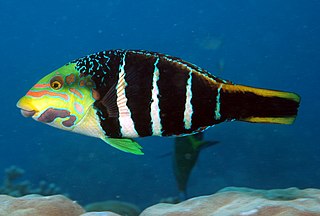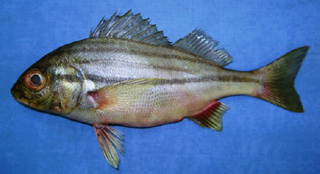
The clown triggerfish, also known as the bigspotted triggerfish, is a demersal marine fish belonging to the family Balistidae, or commonly called triggerfish.

The sergeant major or píntano is a species of damselfish. It grows to a maximum length of about 22.9 centimetres (9.0 in).

The Mercedes-Benz Bionic is a concept car created by DaimlerChrysler AG under the Mercedes Group. It was first introduced in 2005 at the DaimlerChrysler Innovation Symposium in Washington, D. C. The Bionic is modeled after a type of fish, the yellow boxfish, Ostracion cubicus, and also has 80% lower nitrogen oxide emissions with its selective catalytic reduction technology.

The blackspotted puffer, also known as the dog-faced puffer, is a tropical marine fish belonging to the family Tetraodontidae.

Aluterus scriptus, commonly known as scrawled filefish, broomtail filefish or scribbled leatherjacket, is a marine fish belonging to the family Monacanthidae.

The checkerboard wrasse is a fish belonging to the wrasse family. It is native to the area including the Indian Ocean to central Pacific Ocean.
Although most species in the Red Sea pose no threat to humans, there are a few notable exceptions.

The spot-fin porcupinefish, also known as the spotted porcupinefish, black-spotted porcupinefish or simply porcupinefish, is a member of the family Diodontidae.

The cuckoo wrasse is a species of wrasse native to the eastern Atlantic Ocean from Norway to Senegal, including the Azores and Madeira. It is also found in the Mediterranean Sea. They occur in weedy, rocky areas mostly between 40 and 80 m. This species is an occasional food fish for local populations but is also popular as a game fish. It is also a popular fish for display in public aquaria.

Arothron stellatus, also known as the stellate pufferfish, starry puffer, or starry toadfish, is a demersal marine fish belonging to the family Tetraodontidae. It is found in shallow water in the Indo-Pacific region.

Tetrosomus gibbosus, commonly called camel cowfish because of the hump on its dorsal keel, is one of 22 species in the boxfish family, Ostraciidae. It is a ray finned fish. Other common names include helmet cowfish, humpback turretfish and thornbacked boxfish. It is most closely related to T. reipublicae, the smallspine turretfish. T. gibbosus is a species of boxfish found in the wide Indo-West Pacific. It has been recorded since 1988 on rare occasions in the Levantine waters of the Mediterranean Sea, likely following entry via the Suez Canal. It is the first species from the family Ostraciidae to be found in the Mediterranean Sea.

Coral reef fish are fish which live amongst or in close relation to coral reefs. Coral reefs form complex ecosystems with tremendous biodiversity. Among the myriad inhabitants, the fish stand out as colourful and interesting to watch. Hundreds of species can exist in a small area of a healthy reef, many of them hidden or well camouflaged. Reef fish have developed many ingenious specialisations adapted to survival on the reefs.

Lactophrys triqueter also known as the smooth trunkfish, is a species of boxfish found on and near reefs in the Caribbean Sea, Gulf of Mexico and subtropical parts of the western Atlantic Ocean.

Underwater camouflage is the set of methods of achieving crypsis—avoidance of observation—that allows otherwise visible aquatic organisms to remain unnoticed by other organisms such as predators or prey.

The barred thicklip wrasse is a species of fish belonging to the wrasse family, native from the Indo-Pacific.

The chameleon goby is a species of ray-finned fish native to marine and brackish waters along the coasts of eastern Asia. It has also spread to other parts of the world where it is found in waters with varying degrees of salinity.

Halichoeres leucoxanthus, commonly called the canarytop wrasse, whitebelly wrasse, or lemon meringue wrasse, is a fish species in the wrasse family endemic to the Indian Ocean.

Nemipterus randalli, or Randall's threadfin bream, is a species of ray-finned fish from the family Nemipteridae, the threadfin breams, which is native to the western Indian Ocean and the Red Sea, it has invaded the eastern Mediterranean by Lessepsian migration through the Suez Canal.

Pomadasys stridens, the striped piggy or lined piggy, is a grunt from the western Indian Ocean, it is one of a group of Indo-Pacific marine species which have colonised the Mediterranean Sea through the Suez Canal from the Red Sea, a process known as Lessepsian migration.
Pteragogus trispilus is a species of marine ray-finned fish from the wrasse family, the Labridae. It is native to the Red Sea from where it has entered the Mediterranean Sea.


















